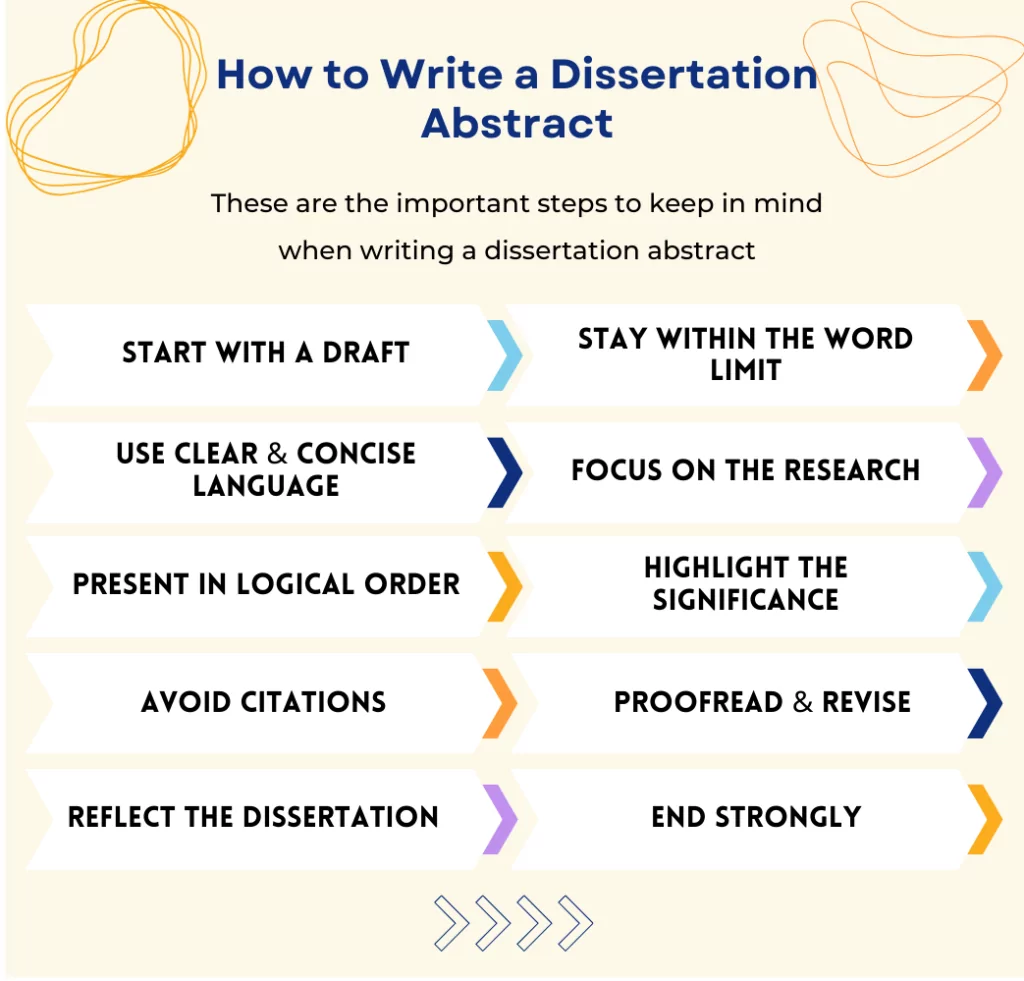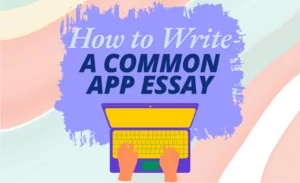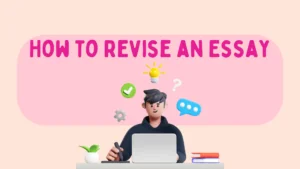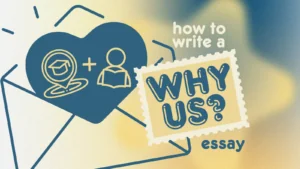The decision to write a dissertation is no small feat. It is a culmination of years of research, analysis, and hard work, all distilled into one comprehensive thesis. Every component of this significant academic project must be carefully planned and implemented. Yet, among all the sections of a dissertation, the abstract holds a special position.

✅ AI Essay Writer ✅ AI Detector ✅ Plagchecker ✅ Paraphraser
✅ Summarizer ✅ Citation Generator
What Is an Abstract of a Dissertation?
So, what is an abstract, and why is it so important? An abstract is a concise and comprehensive summary of a larger piece of work, specifically a dissertation or a thesis. It serves as a roadmap, providing readers with a snapshot of what the entire document entails. The primary purpose of an abstract is to give potential readers enough information to decide whether the paper promises to bring up some essential or interesting discussion questions. It highlights the key points, including the research problem, methodology, results, and conclusions. Essentially, the abstract summarizes the objective, scope, and significant outcomes of the research, ensuring that readers can grasp the nature of the project without digging into the entire document right away. As for its length, while it can vary depending on institutional requirements or the type of research, a typical dissertation abstract is usually between 300 and 500 words. However, adhering to specific guidelines from your academic institution or publisher is always advisable.
The Difference between an Abstract and an Introduction
It’s not uncommon for students, especially those new to academic writing, to mix up the abstract with the introduction. On the surface, they might seem to serve similar functions, both offering insights into the content of the dissertation. However, this is a misconception. While there are some similarities, the abstract and the introduction have distinct roles and characteristics. Understanding these differences is critical to ensure that both sections are effectively written and serve their intended purposes.
Here’s a comparative table highlighting the similarities and differences between an abstract and an introduction:
| Aspect | Abstract | Introduction |
| Purpose | Provides a concise summary of the entire dissertation. | Introduces the topic, sets the context, and outlines the scope and direction of the research. |
| Position in Paper | Typically placed at the very beginning, before the table of contents. | Follows the abstract and precedes the main body of the dissertation. |
| Length | Generally between 150 to 300 words, though this can vary. | Can be several pages long, depending on the complexity and length of the research. |
| Content | Summarizes the research problem, methodology, results, and conclusions. | Discusses the background, presents the research question, and hints at the methodology. |
| Audience | Aimed at potential readers to help them decide if they should read further. | Targets readers who have already decided to engage with the dissertation, setting the stage for them. |
| Tone | More formal and straightforward, focusing on the facts. | Can be more explorative, setting the scene and building interest in the upcoming content. |
While both the abstract and the introduction give an overview of the dissertation, they do so in different ways and for various reasons. The abstract is a snapshot, capturing the essence of the entire research, while the introduction is a doorway, inviting readers into the detailed exploration of the topic. Recognizing and respecting these differences is essential to writing a cohesive and effective dissertation.

Components of a Dissertation’s Abstract
Formulating a compelling dissertation abstract requires a clear understanding of its fundamental components. Each serves a specific purpose, ensuring that readers get a comprehensive overview of the research without having to read the entire document. By understanding the placement, purpose, and estimated length of each component, one can craft a well-structured and comprehensive abstract that effectively conveys the essence of the dissertation. Let’s break down these components and explore what each one entails:
Introduction
Positioned at the very beginning of the abstract, the introduction offers a brief insight into the research topic and its context. Typically spanning 1-2 sentences, it sets the tone by highlighting the subject matter and its relevance in the broader academic or real-world scenario:
“This study examines how digital marketing strategies influence consumer behavior in the e-commerce sector.”
Aims and Objectives
Following the introduction, this section outlines the main goal and specific objectives of the research. Usually 2-3 sentences long, it clarifies the research’s direction and purpose.
“The primary aim was to analyze how online advertising influences purchasing decisions, with objectives to assess the effectiveness of social media campaigns and email marketing.”
Methodology
This component, typically 2-4 sentences in length, provides a snapshot of the research methodology. Positioned after the aims and objectives, it gives readers an idea of the approach taken and the tools or techniques employed.
“A mixed-method approach was adopted, combining quantitative surveys with qualitative interviews. Data was collected from 500 online shoppers and 10 marketing managers.”
Results
The results section, usually 3-5 sentences long, summarizes the main findings of the research. Positioned after the methods, it offers a glimpse into the significant outcomes and discoveries made during the study.
“The results indicated that 70% of consumers are influenced by social media ads, while email marketing showed a 45% conversion rate.”
Discussion
In this section, which can span 3-5 sentences, the results are interpreted and contextualized. Positioned after the results, it delves into the implications of the findings and their correlation with existing literature or practical applications.
“The findings suggest that while social media remains a dominant force in e-commerce marketing, email marketing’s potential is often underestimated.”
Conclusion
The conclusion wraps up the research and is typically positioned at the end of the abstract. Spanning 2-3 sentences, it emphasizes the overall significance and contributions of the study, hinting at broader implications and potential avenues for future research.
“The study underscores the evolving landscape of digital marketing in e-commerce. Further research could explore the role of influencer marketing in shaping consumer choices.”

Below, you can find an example of a simple but precise dissertation abstract on the topic “Impact of Social Media on the Traditional Way of Conducting Business.”
ABSTRACT
Introduction
In the rapidly evolving digital age, few phenomena have been as transformative as the rise of social media platforms. Over the past 10-15 years, these platforms have not only reshaped interpersonal communications but have also brought about significant shifts in the world of business. This dissertation provides an in-depth exploration of the profound impact of social media on traditional business practices within this timeframe.
Aims and Objectives
The research began by setting a clear objective: to understand the multifaceted ways in which platforms such as Facebook, Twitter, LinkedIn, and Instagram have influenced and, in some cases, disrupted conventional business strategies, customer interactions, and marketing paradigms.
Methodology
To achieve a holistic understanding, a mixed-method approach was meticulously chosen. Quantitative surveys were conducted across 1,000 diverse businesses, ranging from startups to established corporations, to gauge the extent of their adaptation to social media. Complementing this, qualitative interviews with 50 industry leaders and veterans provided rich insights into the strategic shifts and challenges faced during this digital transition.
Results
Preliminary results painted a compelling picture: a staggering 65% shift from traditional advertising methods, such as billboards and print media, to social media campaigns was observed. Even more striking was the 75% increase in customer engagement on social media platforms, underscoring their role as the new marketplace.
Discussion
The discussion segment delves deeper, shedding light on the decline of conventional marketing channels and the rise of influencer marketing, targeted ads, and real-time customer engagement strategies. It also touches upon the challenges businesses faced, from data privacy concerns to the constant need for digital upskilling.
Conclusion
In drawing conclusions, the research underscores a pivotal message: the influence of social media on traditional business methods is not just significant but transformative. Businesses that have been agile in adapting to this shift have reaped substantial benefits, while those resistant to change have faced dwindling relevance. As the digital landscape continues to evolve, the lessons from the past decade and a half serve as both a guide and a warning for future business strategies.
Practical Tips for Crafting an Effective Dissertation Abstract
Writing a dissertation abstract can be daunting, especially when trying to condense years of research into a few hundred words. If you struggle to take this feat on your own, consider getting help from a custom thesis service. However, with the right personal approach and some practical tips, you can create an abstract that effectively captures the essence of your research and engages your readers. Here are some tried-and-true strategies to guide you:

- Start with a Draft: Before finalizing your abstract, write a rough draft. This allows you to organize your thoughts, identify key points, and ensure that you’re covering all necessary components. It ensures a smoother writing process and helps identify gaps or areas of emphasis early on. An initial draft can act as a blueprint, making subsequent revisions more focused.
- Stay Within the Word Limit: While including every detail is tempting, remember that an abstract is a summary. Adhere to the word limit set by your institution or publisher, ensuring you prioritize the most crucial information. A concise abstract is more likely to engage readers, ensuring they grasp the essence of your research without feeling overwhelmed.
- Use Clear and Concise Language: Avoid jargon and complex sentences. Your abstract should be understandable to a broad audience, not just experts in your field. Clear language ensures broader comprehension and appeal, increasing the chances of your research being read and cited.
- Focus on the Research: Highlight the research problem, methodology, results, and conclusions. Avoid unnecessary background information or overly detailed explanations. Highlighting the core aspects of your research ensures readers quickly understand its significance and methodology.
- Present in Logical Order: Ensure that the components of your abstract (introduction, aims, objectives, methods, results, discussion, conclusion) flow logically. This structure helps readers follow your research journey. Highlighting the core aspects of your research ensures readers quickly understand its significance and methodology.
- Highlight the Significance: Emphasize the importance of your research and its contributions to the field. Why should someone read your dissertation? What new insights or implications does it offer? Readers are more likely to go deeper into your dissertation if they understand its unique contributions to the field.
- Avoid Citations: The abstract should stand alone. Avoid referencing other works, as there’s no room for detailed citations. A free from-citations abstract is more streamlined and avoids potential confusion for readers unfamiliar with the cited works.
- Proofread and Revise: Once you’ve written your abstract, take the time to proofread. Check for grammatical errors, clarity, and coherence. It’s also beneficial to get feedback from peers or mentors. A polished abstract reflects meticulousness and attention to detail, enhancing the overall impression of your research.
- Reflect the Dissertation: Ensure that your abstract accurately represents your research. Avoid including information in the abstract that doesn’t appear in the dissertation. Ensuring congruence between the abstract and the dissertation guarantees that readers aren’t met with unexpected content discrepancies.
- End Strongly: Conclude your abstract by reinforcing the significance of your research and hinting at its broader implications or potential future directions. By ending on a compelling note, you encourage readers to explore the full breadth of your research, emphasizing its relevance and potential impact.
By understanding and implementing these tips, you guarantee that your abstract is not only a reflection of your research but also a persuasive invitation to readers to explore further.
Common Mistakes to Avoid When Writing a Dissertation Abstract
People are prone to making mistakes, and even the most attentive students can unintentionally do something inaccurate in such a massive paper. Writing an effective dissertation abstract requires not only understanding its essential components but also being aware of common pitfalls. By avoiding these mistakes, you can ensure that your abstract effectively captures the heart of your research and engages your readers.
| Mistake | Why Avoid? | Better Approach |
| Being Vague | An abstract should provide a clear and concise overview of your research. Vague statements can confuse readers. | Be specific about your research objectives, methods, and findings. |
| Introducing New Information | The abstract should only summarize the content of your dissertation. New information can mislead readers. | Ensure that everything mentioned in the abstract is discussed in detail in the dissertation. |
| Overusing Technical Jargon | The abstract should be accessible to a broader audience, not just experts in your field. | Use clear and straightforward language, explaining any necessary technical terms. |
| Neglecting Keywords | Keywords enhance the discoverability of your research in databases and search engines. | Identify and incorporate relevant keywords related to your research topic. |
| Ignoring the Word Count | Exceeding the word limit can lead to your abstract being truncated or rejected by journals or conferences. | Adhere to the specified word count, prioritizing the most crucial information. |
| Writing the Abstract First | Writing the abstract before completing the dissertation can lead to inconsistencies. | Craft the abstract after finalizing the dissertation to ensure it accurately reflects the content. |
| Failing to Highlight the Significance | Readers should understand the importance and implications of your research. | Clearly convey the contributions and significance of your study in the abstract. |
| Not Seeking Feedback | An external perspective can identify gaps or areas of improvement. | Share your abstract with peers, mentors, or advisors for feedback before finalizing. |
Tailoring Your Abstract for Different Platforms and Audiences
When writing a dissertation abstract, it’s vital to consider where you intend to publish or present your work, as different platforms or events might have specific requirements or audiences:
- Academic Journals: Academic journals often come with strict word limits and may demand particular sections or keywords. Given that they cater to a specialized audience well-versed in the field, it’s crucial to adhere to the journal’s guidelines. Focus on the novelty of your research and ensure that your abstract aligns with the journal’s scope.
- Conferences: Abstracts for conferences are typically concise, aiming to attract attendees to your presentation. They might be perused by diverse individuals, ranging from novices to experts. It’s beneficial to accentuate the primary findings and their implications, ensuring clarity and engagement even for those not deeply entrenched in the topic.
- Thesis or Dissertation Repository: Platforms that archive theses and dissertations expect abstracts to offer a comprehensive overview for future researchers. It’s important to ensure the abstract is thorough, encompassing all key components. Incorporating relevant keywords can also enhance its discoverability for those seeking related research.
- General Public Platforms: When sharing research on platforms accessible to the general populace, remember that many might lack a background in your field. It’s advisable to minimize technical jargon, shed light on the broader implications of your research, and underscore its real-world relevance.
- Grant Applications: For research grant applications, the abstract is pivotal in convincing reviewers of your project’s significance and feasibility. It’s essential to spotlight the potential impact of the research, delve into its methodology, and outline the anticipated outcomes.
By understanding the nuances of different platforms and their audiences, you can tailor your abstract to sound more effectively, ensuring it grabs the essence of your research and meets specific requirements at the same time.
Dissertation Abstract Checklist
Before finalizing your dissertation abstract, use this checklist to ensure it meets all general guidelines:
| ✅ Topic | Does the abstract clearly state the research topic and its relevance in the broader context? |
| ✅ Objective | Have you outlined the primary aim and specific objectives of the research? |
| ✅ Methodology | Is there a brief description of the research methodology, including the approach (qualitative, quantitative, mixed) and tools or techniques used? |
| ✅ Key Findings | Have you summarized the main findings or results of the research? |
| ✅ Discussion | Does the abstract touch upon the implications of the findings, their significance, or how they relate to existing literature? |
| ✅ Conclusion | Have you wrapped up the abstract by emphasizing the overall contributions and potential broader implications of the study? |
| ✅ Word Count | Does the abstract adhere to the specified word limit set by your institution, journal, or conference? |
| ✅ Clear Language | Have you avoided excessive jargon and ensured the abstract is understandable to a broader audience? |
| ✅ Keywords | Have you included relevant keywords to enhance discoverability? |
| ✅ Consistency | Does the abstract accurately reflect the content of the dissertation without introducing new or inconsistent information? |
| ✅ Feedback | Have you sought feedback from peers, mentors, or advisors and made necessary revisions? |
| ✅ Proofreading | Have you thoroughly proofread the abstract for grammatical errors, clarity, and coherence? |
Final Thoughts
Writing a dissertation abstract is both an art and a science. It requires distilling complex research into a concise summary containing the essence of months or even years of hard work. As we’ve explored in this guide, a well-written abstract is more than just a summary – it’s a gateway to your research, asking readers to learn more about your findings.
Remember, the abstract is often the first (and sometimes the only) part of your dissertation that many will read. It sets the tone and provides a first impression. By following the guidelines, tips, and best practices outlined in this guide, you can craft an abstract that effectively communicates the significance of your research, resonates with your target audience, and stands out in the academic community.
Whether you’re just starting your research journey or are in the final stages of your dissertation, we hope this guide serves as a valuable resource. Writing is an iterative process, and perfection comes with practice and revision. Seek feedback, be open to adjustments, and always keep your audience in mind. Embrace the challenge of writing your abstract. It’s an opportunity to showcase your dedication, insights, and contributions to your field. Also, do not be scared to ask for help from professionals. For guidance on choosing a reliable provider, refer to the best dissertation writing service review at AcademicHelp.net. We guarantee you can find it useful. Best of luck, and may your research make a lasting impact!
FAQ
Follow us on Reddit for more insights and updates.





Comments (0)
Welcome to A*Help comments!
We’re all about debate and discussion at A*Help.
We value the diverse opinions of users, so you may find points of view that you don’t agree with. And that’s cool. However, there are certain things we’re not OK with: attempts to manipulate our data in any way, for example, or the posting of discriminative, offensive, hateful, or disparaging material.